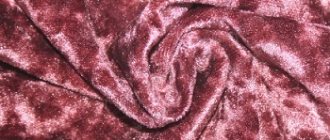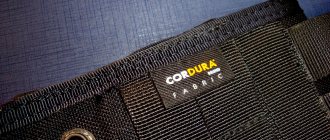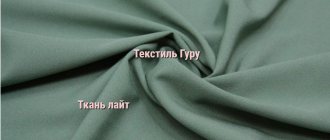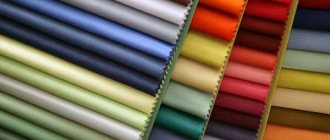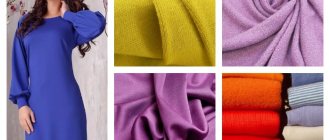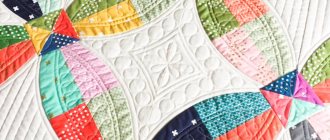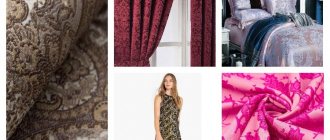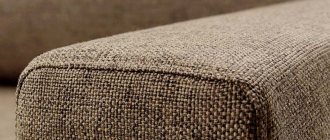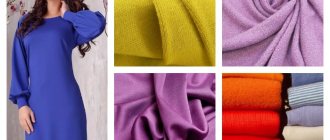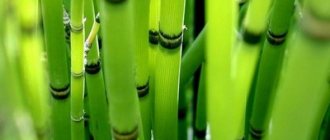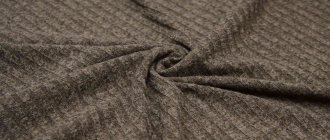In the range of luxury textiles, moire is one of the most popular materials for sewing elegant clothes and expensive interior items. It is impossible not to notice this fabric in paintings by famous artists and in photos in glossy magazines. Mention of it is found in the works of poets and writers of past centuries.
Moiré fabric, what it is, and how an extraordinary effect is achieved on the surface of the material, will be useful to know for those who are starting their journey in the sewing business, and for lovers of stylish things.
Origin story
History cannot name the exact date of appearance of the material. It is known that the production of fabric with a moire pattern dates back to the Middle Ages. The name comes from the French moire, which means “irridescent” or “creating waves.” It is believed that the roots of the expression are directly related to eastern languages.
According to the current version, moire fabric was first made in Persia. The matter was brought to European countries (in the 18th century), where it received its name, which has remained unchanged since then.
Moire has always been considered a symbol of wealth and luxury. Only wealthy people could afford clothes made from it. Camisoles, dresses, and ribbons made from this material can be seen in portraits of monarchs and their entourage. Initially, the canvases were created from premium silk raw materials. Today, iridescent fabric is also made from synthetic fibers.
Waves on posters
But usually moira is considered a defect or artifact, especially, for example, in printing full-color images that involve the overlay of halftone screens.
These are rectangular dot patterns, four of them to be exact, printed in cyan, yellow, magenta and black. You cannot completely get rid of stains and spots, but under favorable conditions the overall image is quite “dense”, and the spatial frequency of moire is so high that it is not noticeable.
In fact, in the visual arts, the term means excessively noticeable distortion, that is, the deliberate use of waves and lines. True, the visibility of moire is not always predictable. Everything is done by trial and error, so sometimes you get amazing images with unusual results, like in a painting by Brian Thomas. Moire with discoloration is shown in the photo below.
Technology for creating moire effect
The moiré effect is the ability of the surface of a material to change color depending on the refraction of light. The waves on the fabric resemble frozen volumetric waves or a woody pattern. The effect is achieved by several methods of textile processing:
- Calendering is the rolling of fabric under pressure at high temperatures between the shafts (rollers) of the machine. As they pass through, the threads woven using the plain method change their structure; As a result, they shift, forming optical glare on the surface.
- A pattern with a shimmer is obtained by changing the method of weaving the yarn, alternating them in a certain order.
- The method of applying the canvases is multi-layering. Mesh fabrics are laid out in layers in a chaotic manner, with the mismatch of threads forming an unusual pattern.
Structure formation or fine design
In addition to developing on fabrics, moire patterns are often an undesirable artifact of digital imaging and computer graphics images. For example, a similar visual effect occurs when scanning a fuzzy image through a transparent checkered pattern.
The photo above shows a moire pattern. The lines can represent the fibers in the silk as ripples or waves, and they can be drawn on paper or appear on a computer screen. To the question of why this happens:
- The nonlinear interaction of systems of multidirectional lines creates a real and visible moire color or pattern of approximately parallel dark and light stripes superimposed on each other in an offset manner.
The photo below is a vivid example of wave visualization.
- If the lines are curved or not exactly parallel, more complex linear moirae are created, as in the photo of the parrot's wing.
- Patterns that reveal complex shapes or sequences of symbols embedded in one of the layers (in the form of periodically repeating compressed figures) usually give very interesting images that are specially created using groups of moiras.
- One of the most important properties of all types of moire is their ability to magnify or stretch tiny forms of lines, stripes, dots along one or both stretch axes, creating stunning 2D effects.
A general 2D example of magnification and distortion of the underlying pattern can be seen by viewing a chain link through another chain link of identical design. The subtle design of shimmering ripples is clearly visible even from a distance.
What color is moiré? A photo of a garage door shows a pattern - the effect of the design lines shifting relative to each other. The gate is a structure of two planes with metal strips connected with an offset.
Description
Popular colors of moire fabric
Moire fabric is a silky material with a surface that shimmers under the rays of light. Pleasant to the touch, light, not translucent. The pattern formed on the fabric resembles waves or rings of wood. With the development of new technologies, views with a holographic effect have appeared. To obtain it, a multi-layer method is used, overlaying organza and chiffon fabrics.
Expert opinion
Alyona
Fabric expert and technologist Alena Khlebnikova is ready to answer your questions.
Write to us
The material drapes well and holds its shape. Performance characteristics depend on the composition of the fibers. Moiré made from natural silk is the most expensive type of textile and demonstrates high hygienic properties. Provides good vapor permeability, air exchange and hygroscopicity.
The fabrics do not shrink and are resistant to UV rays. The color palette of textiles is rich: from pastel to bright saturated colors. The more clearly expressed the moiré stripes on the surface, the more expensive the fabric.
Characteristics and descriptions of the main properties of classic types of textiles are given in the table below:
| Characteristics | Indicators |
| Raw material type | Natural animal and plant origin, synthetic, artificial |
| Weaving method | Linen, mixed |
| Density, g/m2 | From 150 |
| Standard width of canvases, cm. | 140, 290, 300 |
| Side | Double-face weave |
| Fibers used in production | Silk 100%, silk + cotton (weft threads), silk with the addition of viscose, acetate, lavsan; polyester |
| Water resistance | Depends on the composition |
| Hygroscopicity,% | |
| Moisture absorption rate |
Open to see the entire table
| Vapor permeability | good |
| Air exchange indicators | Average for natural and mixed species |
| Electrification | Moderate |
| Color palette | Wide |
| Coloring methods | Plainly dyed canvases with moiré effect, plain |
| Types of material | Gromoire, moire antique, velvet |
| Wrinkleability | Present, may form difficult to smooth out creases |
| Strength and wear resistance indicators | High |
| Manufacturer | Italy, Türkiye, China |
| Standardization | GOST 28253 – 89; 29223 – 91; 29298 – 2005 |
| Price | High. Synthetic types from 700 rub. for 1 meter, mixed and natural - from 1500 rubles. (for Italian paintings - from 3000 rubles) |
Types of moire fabrics
Gromoire (grimoire) and antique are two main types of material that differ in production technology. In addition to smooth fabrics, velvet moire is popular in the textile group.
Gromoire
The group of gromoire fabrics includes plain weave material that has been processed by calendering. Textiles with fine optical patterns and pronounced iridescence. They are made mainly from high quality silk fibers.
Velvet moire
The production technology of this material is fundamentally different from the classical method. The moiré effect is achieved by alternating fibers of different lengths and colors. Velvet or velor material (moire velour) requires careful care, and most often dry cleaning is used for this type.
Moiré antique
A group of fabrics made by alternating types of weaving is called moire-antique (moire-antique). These are thin, light canvases with expressive patterns. This method produces varieties of material with a matte gradient color shift (transition from a light to a more saturated shade).
Multilayer moiré
The method of applying thin transparent sheets to obtain moiré stripes is used less frequently than others. The fabric is made using a combination of chiffon and organza.
Flaw or Feature: Moire Color in Fine Art
It is quite difficult to imitate colored moira using modern technologies and still achieve a high-quality image.
The best color schemes come from fabric designs or finely constructed fences.
Black and white moire is more amenable to experimentation. For example, the Italian designer Andrea Minini began an experiment in designing images of animals with a graphical offset effect.
- In order to achieve complex shapes and depth, he begins drawing the object with a small number of basic lines.
- Using Adobe Illustrator, Minini deepens the design in different directions, creating wonderfully textured moire patterns.
- Each illustration is unique and interesting with its intense expressiveness.
Moire color and shape, photo by Andrea Minini.
Application
The noble, refined appearance determined the scope of application of moire canvases. Previously, when fabric was produced exclusively from silk raw materials, wear resistance and strength were low. With the advent of innovative technologies, the material has become durable. Having survived several periods of oblivion, he periodically returned to fashion catwalks. Today, moire fabrics are again at the peak of popularity.
Products with moire effect
The following products are made from them:
- made from low-density fabrics - classic-cut blouses for offices;
- elegant evening and wedding dresses;
- concert costumes;
- decorative pillowcases and bedspreads;
- curtains, drapes, awnings;
- from velvet fabrics - blazers, jackets, jackets, interior items;
- furniture covers;
- decorative items for halls for celebrations;
- tablecloths;
- clothing and decorative items for clergy.
